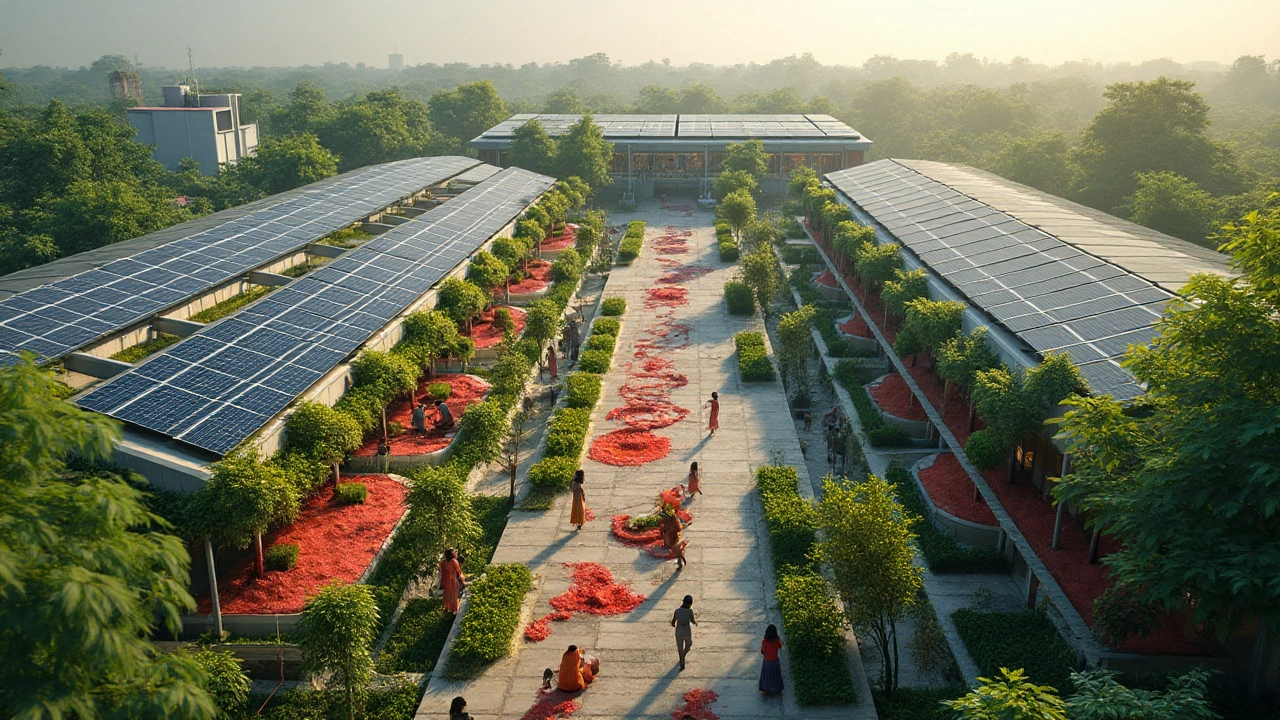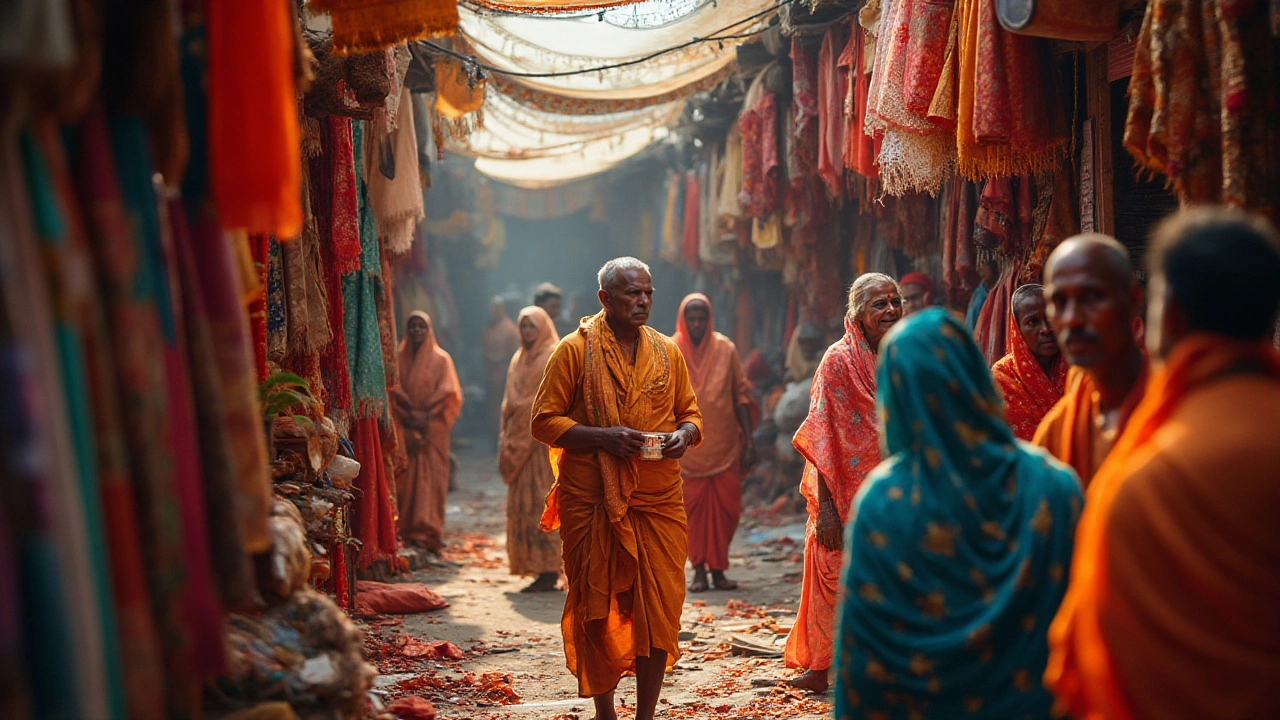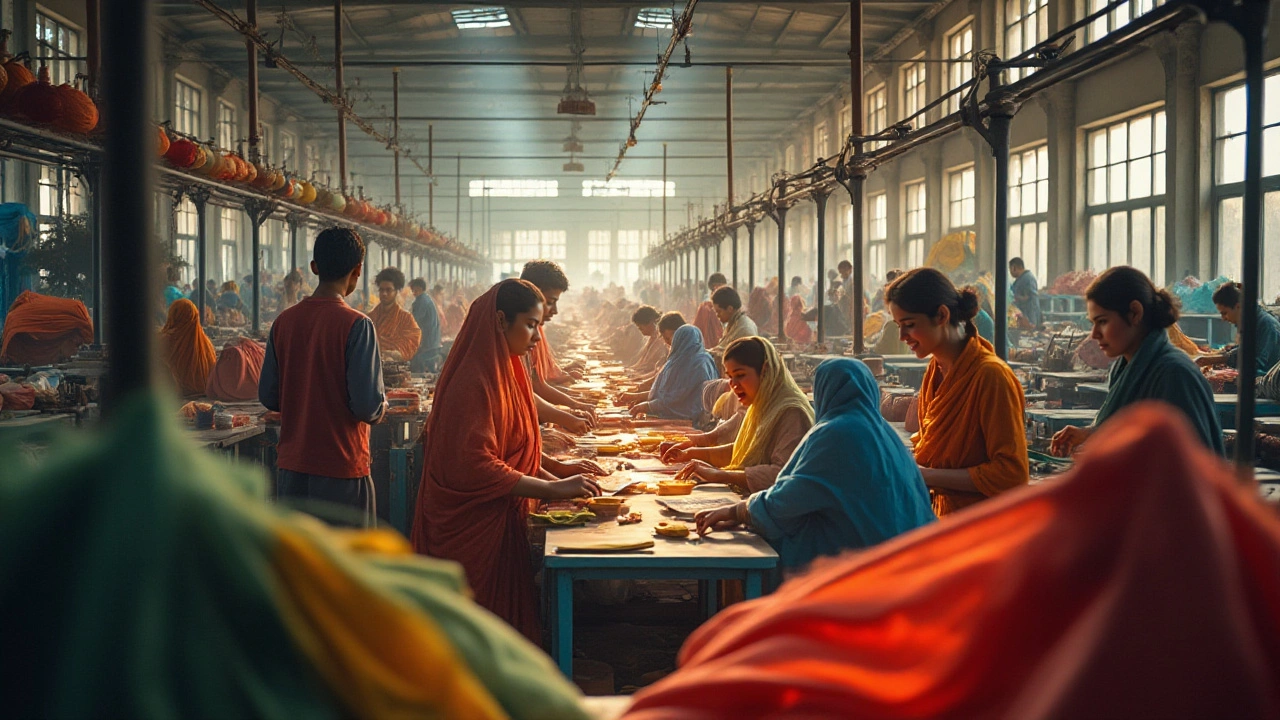The world of textile manufacturing is a dynamic landscape, constantly shaped by innovation, economic shifts, and cultural influences. It’s a sector that has seen leaders emerge time and again, with certain countries standing out thanks to their cutting-edge technology, skilled workforce, and robust supply chains.
As of 2025, the global textile stage is dominated by a few key players, each contributing uniquely to the industry. The interplay of tradition and modernity characterizes these nations, showcasing their ability to adapt and evolve with changing market demands. From intricate silks to durable denims, the textile industry continues to thrive, catering to the diverse fabric needs of the world.
- Introduction to Textile Manufacturing
- India: A Textile Powerhouse
- China: The Global Leader
- Rising Stars in Textile Manufacturing
- Future Trends in Textiles
Introduction to Textile Manufacturing
Textile manufacturing stands at the confluence of art and industry, a testament to human ingenuity spanning millennia. As human civilization blossomed, textiles transcended mere utility, becoming an integral part of cultural identity and economic prowess. This transformative industry has roots deeply embedded across continents, evolving from hand-spun fibers to the mechanized looms of today. At the heart of this evolution lies the adaptability of the industry, continuously harnessing new technologies and methods to produce a diverse array of fabrics. The ability to weave innovation with tradition is what propels leading textile countries to the forefront, making them indispensable to the global market.
The significance of the textile industry is underscored by its colossal contribution to employment worldwide, particularly in developing countries where it often serves as a cornerstone for economic growth. It's fascinating to note that the textile sector accounts for a significant portion of industrial employment in nations like India and Bangladesh. The tapestry of the industry is woven with various processes, from spinning and weaving to dyeing and finishing, each fraught with its own set of challenges and breakthroughs. Recent years have seen a shift towards sustainability, with manufacturers investing in eco-friendly practices to mitigate the environmental impact of traditional textile production.
As a Harvard Business Review article notes, "The future of the textile industry relies not only on technological advancement but on our ability to balance ecological concerns with economic imperatives." (
Harvard Business Review) This sentiment rings true as the industry grapples with the dual demands of scaling production while reducing carbon footprints. Innovations like waterless dyeing and biodegradable fibers are gaining traction, offering a glimpse into a future where fashion meets environmental responsibility.
The industry's global nature presents both opportunities and challenges. The intricate supply chains span continents, with raw materials often sourced from different countries than where garments are ultimately produced. This interdependence means that geopolitical events, such as trade wars or pandemics, have far-reaching impacts on textile manufacturing. As such, agility and strategic foresight are vital for businesses navigating this complex landscape. Companies that succeed in marrying quality with timely delivery often emerge as leaders, driving trends in the textile manufacturing world.
As we delve deeper into the dynamics of textile manufacturing, it becomes clear that the sector's vibrancy stems from its ability to continuously reinvent itself in the face of change. By embracing both the technological advances and the cultural shifts that shape consumer demand, the industry not only survives but thrives amidst global uncertainties. This exploration will take us through the realms of leading textile manufacturers, tracing the threads of innovation and tradition that hold this vital industry together.
India: A Textile Powerhouse
India has long been recognized as a textile manufacturing giant, and its influence in this sector continues to grow with each passing year. The country's textile heritage dates back thousands of years, contributing richly to its cultural and economic development. From the lush cotton fields of Gujarat to the silk-weaving artisans of Varanasi, India's textiles canvas is as diverse as it is vast. In recent years, the nation has solidified its position as a leading textile manufacturer, driven by a combination of traditional craftsmanship and cutting-edge technology.
The significance of textiles in India transcends mere economic utility—it is a tapestry of tradition and innovation. The sector employs millions, with the government supporting initiatives to sustain and elevate India's textile prowess. The introduction of schemes like the Integrated Processing Development Scheme (IPDS) aims to modernize and expand key infrastructure, boosting production capabilities and reducing environmental impact. The sector's adaptability is evident in its response to global shifts, as seen in the rise of sustainably sourced materials and the adoption of eco-friendly practices.
India's textile industry is a colossal entity, contributing heavily to the national economy with substantial export volumes. According to the Ministry of Textiles, India ranked as the second-largest textile manufacturer worldwide by output, trailing closely behind China. The country's global competitiveness is bolstered by its vast pool of skilled labor and cost-effective production processes, attracting international brands seeking large-scale manufacturing partners. A testament to this strength is the array of diverse textiles India exports, including handwoven fabrics, synthetic blends, and intricate embroideries.
Investment in innovation and quality has enabled India to stay ahead of the curve, adapting to emerging trends such as digital printing and smart textiles. Collaboration between traditional artisans and modern designers results in unique, globally appealing textiles. India's prowess in cotton production is particularly noteworthy, contributing to nearly a quarter of the world's cotton production. The use of technology in spinning and weaving has increased efficiency and quality, cementing India's reputation as a top-tier textile supplier.
Rising labor costs in other countries have further enhanced India's appeal as a textile supplier. The Indian government continuously supports the industry's expansion through targeted policies and financial incentives, encouraging foreign investments and facilitating partnerships. Such strategies have nurtured a conducive environment for innovation and growth, empowering local manufacturers to compete on the global stage.
"The diversity and depth of Indian textiles are unparalleled," says Ritu Kumar, a renowned fashion designer. "India's fabric artisans continue to inspire fashion worldwide, merging traditional aesthetics with contemporary demands."
Yet, challenges persist, including global competition and fluctuating demand. Strategic focus on sustainability and quality remains critical as Indian textiles navigate these obstacles. The industry’s resolve to integrate sustainable practices positions India as a responsible leader in textile manufacturing, attracting conscious consumers and fostering long-term growth.

China: The Global Leader
China has firmly established itself as the global leader in textile manufacturing, a title it holds due to several key factors. One of the primary reasons behind this dominance is its ability to leverage a vast labor force complemented by advanced technology. The synergy between traditional craftsmanship and state-of-the-art machinery has positioned China at the forefront of fabric innovation. Beyond sheer production volume, China offers an impressive variety in its textile products, ranging from high-quality silk to modern synthetic blends.
Historically, China's prowess in textiles can be traced back to the Silk Road era, when silk was considered a luxury throughout the world. Today, this legacy continues with an expansive array of textile exports that reach every corner of the globe. In recent years, Chinese manufacturers have embraced eco-friendly practices, aiming to meet the growing demand for sustainable fashion. With an increasing number of factories adopting renewable energy and reducing carbon footprints, China is gradually transforming the industry narrative from mass production to responsible production.
"China's capability to maintain competitiveness in the global textile market stems from its robust infrastructure and continuous investment in innovation," remarked a senior analyst from McKinsey & Company, highlighting the country's strategic focus.
Investment in research and development has played a critical role in China’s textile ascension. The government supports these efforts with policies that encourage technological upgrades and quality enhancements. Companies such as Shenzhou International and Jiangsu Sunshine Group have become industry leaders not only in production but also in R&D, setting new standards worldwide. As global leaders in textile manufacturing, these companies illustrate how a strong commitment to quality and innovation can drive success.
Despite its strengths, China faces challenges including rising labor costs and international trade tensions. In response, many Chinese firms are moving operations to other potential rising stars in textile manufacturing countries to maintain cost-effectiveness. This diversification strategy is part of a broader initiative to ensure continued growth and market competitiveness. In essence, China's leadership is not just built on size and scale, but also on an adaptive approach to the ever-evolving landscape of global trade.
Rising Stars in Textile Manufacturing
In recent years, several countries have emerged as significant contenders in the textile manufacturing industry. These rising stars are not only making waves with their innovative approaches but also challenging traditional leaders by leveraging their unique resources and opportunities. Among these emerging nations, Vietnam stands out prominently. Known for its strategic location and rapidly expanding manufacturing sector, Vietnam is increasingly becoming a favorite production hub for international brands. The country’s government has made notable investments in infrastructure and technology, specifically aimed at boosting the textile industry.
Bangladesh, another emerging powerhouse, is making headlines with its thriving garment industry. The country has shown remarkable resilience and adaptability, focusing heavily on sustainable practices. Many global brands are eager to tap into Bangladesh's competitive pricing and skilled workforce. According to recent reports, Bangladesh's export of textiles reached an all-time high, indicating its upward trajectory in the global market. "The dedication to improving workers' conditions and adopting green technologies is driving Bangladesh's growth," commented an industry expert in a recent publication.
"Countries like Bangladesh and Vietnam aren't just manufacturing textiles; they are redefining the industry's standards through sustainability and innovation," notes Dr. Erika Yu, a manufacturing specialist.
Neighbouring Cambodia is also gaining momentum. Though relatively smaller in scale, Cambodia is quickly climbing the ranks with a focus on high-quality craftsmanship and ethical production processes. Many young entrepreneurs in the region are infusing fresh ideas and taking bold steps, incorporating digital solutions to enhance productivity. Additionally, the rise of regional trade agreements has provided these nations with enhanced market access, helping them secure a firm foothold in the global arena.
Even in Africa, countries like Ethiopia are seeing a surge in textile production. Government incentives and foreign investments have facilitated Ethiopia's ascent in textile manufacturing. The nation’s focus on harnessing local cotton resources and improving production facilities is garnering attention. With a youthful population eager to engage in manufacturing industries, Ethiopia is poised to become a leading player in the near future.
Given the dynamic nature of the textile industry, it is evident that the rise of new players is pushing established countries to innovate and adapt. Their unique blend of tradition and visionary strategies ensures that the textile map remains ever-evolving, promising exciting developments in the years ahead. The constant emergence of these rising stars is crucial for a vibrant and competitive global textile market.

Future Trends in Textiles
As we look towards the horizon, the textile industry stands on the cusp of revolutionary transformations driven by advanced technologies and sustainable practices. With the increasing consciousness around ecological impacts, manufacturers around the globe are investing in eco-friendly alternatives and methods. A prime example is the rise of biodegradable fabrics made from sustainable resources like bamboo and organic cotton. These innovations cater to an audience demanding ethically produced and environmentally responsible products.
Another significant trend shaping the future of textiles is the integration of smart textiles. These are fabrics embedded with electronic components that can collect, transmit, and receive data. From health monitoring clothes that assess vital signs to workout gear that tracks fitness metrics, **smart textile manufacturing** is rapidly advancing. According to a report by the World Economic Forum, the smart textile market is projected to grow significantly, reaching billions in the next decade. Such growth points to a future where our clothing does more than just cover us.
Technological Advancements
Innovation in textile machinery is another area witnessing unprecedented growth. Automation and AI are being increasingly applied to streamline production, improve precision, and reduce waste. Cutting-edge technology is allowing manufacturers to produce complex designs with ease, reducing the dependency on manual labor. It's not surprising to see robotics being adopted for processes like dyeing and weaving, enhancing efficiency and ensuring consistency in quality.
With advances in technology, personal customization is becoming a pivotal trend within the industry. Consumers are no longer content with off-the-shelf clothes; they desire bespoke experiences. 3D printing is at the forefront of this transition, enabling unique designs tailored specifically to individual tastes. This not only heightens the consumer experience but also reduces excess stock, aligning with broader sustainability goals.
Global Shifts and Potential Challenges
Geopolitical factors and economic policies will inevitably influence how textile giants like China and India navigate the industry's future. As regions like Africa emerge with competitive labor costs and an increasingly skilled workforce, they might challenge the dominance of current leaders in **textile manufacturing**. Such shifts require incumbent giants to continuously innovate and adapt to maintain their positions on the global stage.
However, the winds of change come with their own set of challenges. Global supply chains face disruptions from political tensions and environmental crises. Thus, resilience becomes critical. The industry's ability to adapt swiftly, embracing local sourcing and flexible strategies, will likely define its sustainability. It's this adaptability that will determine which countries remain at the forefront of textile innovation and production.
"The future of textiles is not just in producing more, but in creating future-ready, sustainable solutions that cater to the evolving needs of tomorrow’s consumers," the CEO of a leading textile firm remarked in a recent industrial conference.
The textile landscape is indeed evolving rapidly. With technology and sustainability paving the way forward, the ability to adapt is imperative. Industries will need to embrace these trends to cater to the more informed, conscious, and tech-savvy consumers of the future.
